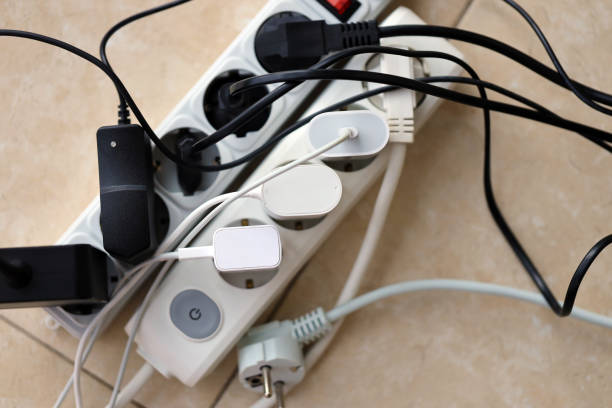Last Updated on August 23, 2024 by Silvy
Be Careful: The Risks of Leaving Electronics Plugged In: In today’s hyper-connected world, it’s easy to overlook the potential hazards associated with leaving our electronics plugged in.
We often take for granted that our gadgets, once switched off, are no longer a concern. However, leaving electronics plugged in poses several risks that can have serious consequences, from fire hazards to increased energy bills.
Understanding these risks can help you make informed decisions about your device usage and ensure your safety.

Understanding the Risks of Leaving Electronics Plugged In
1. Fire Hazards: The Hidden Danger
One of the most alarming risks of leaving electronics plugged in is the potential for electrical fires. Electronics, when plugged in, continue to draw power even if they are turned off.
This constant power draw can lead to overheating, especially if the device or its wiring is damaged. Over time, this can cause an electrical fire, which can be devastating.
- Faulty Wiring: Devices with frayed or damaged cords are especially dangerous. They can short-circuit and spark fires if left plugged in.
- Overheating: Even when turned off, electronics can overheat if they are plugged in for extended periods.
2. Energy Consumption and Increased Bills
Leaving electronics plugged in also affects your energy consumption. Devices such as chargers, even when not in use, continue to draw small amounts of power.
This phantom power consumption adds up over time, leading to increased utility bills.
- Standby Power: Many appliances use power while in standby mode, contributing to higher energy costs.
- Cost Impact: Over the course of a year, the cumulative cost of this standby power can be significant.
3. Shortened Device Lifespan
Electronics left plugged in for long periods can suffer from reduced lifespan. Heat generated by continuous power flow can damage internal components, leading to malfunctions and a need for earlier replacements.
- Battery Damage: For battery-operated devices, constant charging can degrade battery health, reducing its overall lifespan.
- Component Wear: Electrical components can wear out faster if they are always powered.
4. Security Risks: Unauthorized Access
Modern electronics often have connectivity features such as Wi-Fi or Bluetooth. Leaving these devices plugged in can create security vulnerabilities.
Hackers may exploit these connections to gain unauthorized access to your personal data.
- Network Security: Devices connected to the internet are potential targets for cyber-attacks.
- Data Theft: Unsecured devices can lead to the theft of personal and sensitive information.

Best Practices for Managing Electronics
1. Unplug Devices When Not in Use
The simplest way to mitigate the risks associated with leaving electronics plugged in is to unplug them when they are not in use. This prevents potential hazards and reduces energy consumption.
- Use Power Strips: Invest in power strips with on/off switches to make unplugging easier.
- Regular Checks: Make it a habit to unplug devices before leaving home or going to bed.
2. Invest in Smart Plugs
Smart plugs can help manage your electronic devices more efficiently. These plugs can be controlled remotely via smartphone apps, allowing you to turn off devices even when you’re not at home.
- Remote Control: Manage power usage from anywhere.
- Energy Monitoring: Some smart plugs track energy consumption, helping you make informed decisions about your usage.
3. Regular Maintenance Checks
Regular maintenance of your electronics can prevent issues related to overheating and damage.
- Inspect Cords: Regularly check for signs of wear or damage on cords and plugs.
- Ventilation: Ensure that devices have proper ventilation to avoid overheating.
4. Educate Yourself and Others
Understanding the risks associated with leaving electronics plugged in and educating others can help reduce potential hazards.
- Awareness: Share information about the importance of unplugging devices with family and friends.
- Training: Provide training on safe device usage and maintenance.

Conclusion
In summary, leaving electronics plugged in poses several risks, from potential fire hazards to increased energy consumption and shortened device lifespans.
By adopting simple practices such as unplugging devices when not in use, investing in smart plugs, and maintaining your electronics, you can mitigate these risks and ensure both your safety and financial savings.
Awareness and proactive measures are key to preventing the dangers associated with idle electronics.
FAQs
What are the main risks of leaving electronics plugged in?
Leaving electronics plugged in can lead to fire hazards, increased energy bills, shortened device lifespan, and security vulnerabilities.
How can I reduce the risk of electrical fires from plugged-in devices?
Unplug devices when not in use, inspect cords regularly for damage, and ensure proper ventilation around electronics to prevent overheating.
Does leaving a charger plugged in waste electricity?
Yes, chargers left plugged in consume energy even when not in use, contributing to higher electricity bills.
What is phantom power consumption?
Phantom power consumption refers to the energy used by devices while they are plugged in but turned off. This can add up over time and increase your energy costs.
How can smart plugs help manage power usage?
Smart plugs allow you to control devices remotely, track energy usage, and schedule on/off times to reduce unnecessary power consumption.
Can leaving electronics plugged in damage their batteries?
Yes, constant charging can degrade battery health and reduce the overall lifespan of battery-operated devices.
How often should I check the condition of my electronic cords and plugs?
It is a good practice to check cords and plugs regularly, at least once a month, for any signs of wear or damage to prevent potential hazards.
References:


